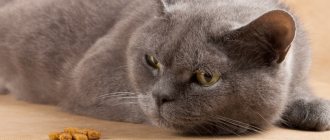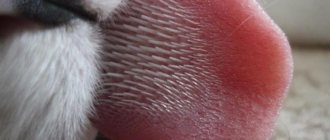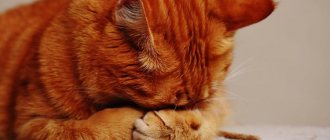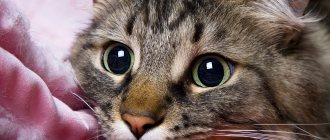Deafness is often difficult to determine, especially because the cat may not report any hearing problems. Usually the first signs an owner notices are the animal not obeying commands or not responding to family noises.
Compared to humans, cats have a completely different sound range. In humans it ranges from 20 Hz (bass sound) to 20 kHz (= 20,000 Hz, high sound). The cat, however, is capable of hearing sounds whose frequency ranges from approximately 48 Hz to 85 kHz.
Deafness can be hereditary in many breeds and may also be due to genetic predisposition. Cats with white fur and blue undertones are predisposed to deafness.
How can I tell if my cat is deaf?
As we mentioned at the beginning of the article, it is difficult to determine deafness in cats, especially if it is only one ear or partial deafness. Since pets cannot communicate that they cannot hear, the best test for confirming the presence or absence of deafness is to observe the cat's reaction to sounds (the animal must be consciously aware of the sound).
For example, try different types of noises and from different objects (starting with soft noises, gradually increasing the intensity) and observe how the cat reacts (or not) to them. Often cats will make an involuntary movement of their ears (known as the "Pryor reflex") in response to sound.
If you suspect your cat may have a hearing problem, consult with your veterinarian to determine the type of deafness and how to intervene.
Causes
If the coat has become oily, it could be due to improper care or various diseases.
Main reasons:
- excess hormones in cats and sterilized animals of both sexes, which leads to increased work of the sebaceous glands;
- poor nutrition, excess fatty meat and fish in the diet, lack of vitamin supplements;
- pathology of the thyroid gland;
- helminths;
- liver or kidney disease;
- skin diseases, including seborrhea.
Depending on the identified cause, the veterinarian prescribes treatment for the animal.
Excess of male sex hormones in cats
With this pathology, under the influence of an excess amount of hormones, the tail gland of cats begins to secrete excess secretion. The tail and sides of the animal become greasy, and the fur becomes greasy.
This pathology can also appear with problems with the adrenal glands. Hormonal imbalance can only be detected through tests. Based on their results, treatment will be prescribed.
Nutrition
If the cat's food does not change for a long time, there are no dairy products, cereals, or vitamin supplements, this leads to a deterioration in the quality of the coat. Sloppy, greasy coat is a consequence of a lack of nutrients.
It is necessary to change the food, diversify the diet, and add vitamin supplements. In about a month there should be improvement .
If this does not happen, you should look for another reason for this condition in cats.
Symptoms
In a cat, the process that leads to deafness usually occurs gradually. Cats have the ability to easily rely on other senses to compensate for any specific sensory deficits, and it is likely that an owner will not be able to realize that the animal is deaf until it has lost most of its hearing ability.
A cat that becomes deaf has subtle signs. For this reason, many owners tend to wonder if the animal has decided to ignore it completely. For example, if previously it was enough to call the cat verbally, shake a package of crunchy crackers or open a can of meat for it to jump out after a few minutes, now you need to look for it to show that food is in the bowl, this can be a revealing sign. Other examples might be a cat's fearful reaction when you pet it and it is relaxed, or the cat's unresponsiveness to a common call such as “Come here!”
If your cat appears to be losing hearing, make an appointment with your veterinarian. Hearing loss is generally not a serious condition, but it is advisable to ensure that there are no underlying conditions that may be contributing to the problem.
How to remove mats from a cat at home
The owner can tidy up the pet's fur on his own. To remove a small amount of tangles you will need:
- product for home or professional cat hair care;
- comb with sparse and non-sharp teeth;
- tangle cutter (there are different types);
- a brush or a special glove for combing.
Particular attention should be paid to the choice of products that make it easier to comb the coat. They must be hypoallergenic, suitable for a certain type of wool, and have a high-quality composition. For example, the Elite spray conditioner from the Elite Professional series with allantoin, glycerin and a complex of conditioning components is suitable. It is adapted for home use, has an antistatic effect to reduce electricity, a softening and moisturizing effect, adds shine to the animal's coat, facilitates combing and prevents tangling.
Before purchasing cosmetics and grooming tools, you should consult a specialist in the field of cat grooming.
Steps to remove tangles:
- Spray the spray onto dry hair to make combing easier.
- Gently untangle the tangles with a wide-tooth comb. If this is not possible, you need to cut off the tangles with a special tool or nail scissors with thin rounded blades.
- Gently comb the fur with a brush.
In particularly advanced cases, if the cat is aggressive and restless, it is advisable to carry out the procedure together. One person holds the pet, the second removes tangles. This will avoid injury to the animal’s skin and protect the owner from scratches. After the procedure, you should treat the cat with a treat.
If you can’t deal with your cat’s tangles on your own, it’s better to go to a grooming salon. Specialists will help you put the fur in order, if necessary, give the animal a haircut and give recommendations on proper care. A hygienic clipper cut can be done under general sedation in a veterinary clinic.
Spray conditioner "Elite" of the Elite Professional series can be used not only on dry hair, but also after washing the cat on a slightly dry coat to make combing easier. For bathing, you can choose shampoo and balm “Elite” that are suitable for your coat type - professional products for regular care. After rinsing, you need to dry the coat a little, apply conditioner spray and comb it.
Types of deafness
There are two types of deafness in cats: conductive or sensorineural.
Conductive deafness
When sounds cannot travel properly through the outer ear or middle ear, the problem is called a conduction problem. This can happen if there is an ear infection, a ruptured eardrum, occlusion of the ear ducts, or fluid inside the ear. Typically, these patients have only partial hearing loss, and treatment involves medical or surgical correction.
Sensorineural deafness
When sensorineural deafness is present, the inner ear is involved and the deafness is usually complete. Sensorineural deafness often occurs due to neural problems or problems with the fluid dynamics or physical properties of the inner ear. Deafness is quite common in pets as they age, and sensorineural deafness may be the cause.
Preventing the appearance of mats in cats
It is easier to prevent tangles from appearing than to untangle and comb them out later. To do this, it is important to follow the following rules.
Health monitoring
It is recommended to regularly examine the cat at home, for example while brushing or playing, and to have a medical examination with a veterinarian 1–2 times a year. At the first signs of illness or the presence of alarming symptoms, the animal should be taken to the veterinarian as soon as possible.
Balanced diet
Proper nutrition, taking into account the daily need for nutrients, vitamins and minerals, taking, if necessary and only on the recommendation of a doctor, complex vitamin-mineral preparations, fatty acid complexes, and having clean water available at all times are some of the main conditions that have a beneficial effect on the beauty of the coat. pet.
Careful proper care
It includes combing and periodic washing using special shampoos selected taking into account the type of animal's coat, as well as additional cosmetics to facilitate combing. In addition, it is important to prevent the air in the room where the pet lives from drying out.
For daily combing of fluffy cats, you will need combs with sparse, non-sharp teeth and special brushes. It is better to carry out the procedure in several stages so as not to cause fatigue and irritation to the animal. When combing, special attention is paid to the armpits, belly, tail, and areas behind the ears. It is necessary to accustom a cat to such manipulations from an early age. In addition, daily brushing helps not only maintain the aesthetic appearance of the coat, but also strengthens the emotional connection between the owner and the cat, allowing you to show your pet your love and care.
Diagnostics
Hearing loss usually occurs as a result of damage to components of the ear: the eardrum, middle or inner ear structures, and nerves. It can also be a consequence of illness or aging.
Cats that experience hearing loss are called "always sleepers," meaning loud, medium, or even soft noises may not wake him up. If your cat usually wakes up as soon as she hears your footsteps, try to see how close you need to get to the cat in order for her to react in response to your presence. If she only reacts when you touch her, this may be a sign of a hearing problem. Another example: If your cat doesn't come when you try to call him from another room, the problem may be related to possible hearing loss rather than one of the classic cat ways of testing your patience.
Diagnoses can usually be formulated through observation, but a veterinarian can accurately diagnose hearing loss using the BAER (Brainstem Auditory) test. The procedure is painless and takes 10-15 minutes. The veterinarian will apply an acoustic stimulus to each ear separately, using headphones or a foam insert. Computers will then record the changes in electrical activity in the brain caused by each acoustic stimulus. The relationship between electrical potential and anatomical structure allows for the presence of possible lesions in the acoustic pathway to be identified with considerable accuracy. Thus, this test allows for early detection of subclinical lesions (that is, those that do not show visible symptoms) in the auditory system.
Many cats diagnosed with hearing loss can still live happy lives. In fact, they can easily learn to respond to gestures, facial expressions, or even light signals. Therefore, it will be necessary to change the methods of interaction with the cat, but there are many successful cases.
In our pet hotel “Pets in Joy” we are ready to accept cats even with such disabilities and diseases as deafness. The staff will treat such guests with the utmost care.
Why are tangles dangerous?
if you ignore the formation of tangles, this can affect the health of your pet
Mats spoil the appearance of your pet. They make the cat look untidy. Professional breeders can ruin their reputation if a purebred cat looks unkempt. And even if the pet is a simple domestic cat, but with tangles, it will be unpleasant to stroke it. However, in addition to not being aesthetically pleasing, pets with mats are at risk of diseases:
- germs and parasites;
- dermatological problems;
- the cat may damage its skin.
Mats can form from wool that is wet (with saliva), and in the form of a lump, the wool will not be able to dry at all. This saliva can harbor parasites and germs. Their activity on the animal's skin can lead to dermatological problems. And the same problems can arise without exposure to parasites. The skin under the mat will become hot and overheat. Experiencing severe itching and discomfort, the cat will try to scratch its skin and remove mats. This way, the cat can damage its skin with its claws and teeth, and the resulting scratches can become infected.
What it is
Mats are pieces of wool matted into a dense lump. If the entire cover is dotted with them, we can say that the owner pays little attention to his pet.
Physiologically, the coat is renewed at certain intervals.
If you do not help the animal get rid of old villi, they can adhere to newly grown hairs under the influence of static electricity.
Lumps are most often observed behind the ears, tail, thighs, belly and armpits. It is where the body is subject to the most friction.
In long-haired cats, villi are collected in clumps on the back, in places where the animal is unable to reach.
Most often, decorative breeds suffer from this problem: Persian, Siberian, Norwegian Forest, Burmese, Turkish Angora, Masquerade Neva, Maine Coon . Their tongue is not suitable for actively combing out pellets.
Cats with short coats also have some flaws. Their fur can become clumps due to paint, varnish, resin, jam and other sticky or sticky substances getting on their fur.
Who is most likely to have tangles?
There is an opinion that cats' hair falls off more often than cats. Males supposedly pay less attention to themselves. Although such a statement is not confirmed by official statistics and is based only on the observations of not entirely happy owners.
If we move aside the gender factor, then we can say with great confidence that wool falls into tangles more often in elderly or sick animals. This is due to weakened immunity, which affects heavy molting, as well as the frailty of the old animal.
Rules for removing cat mats
Vomiting blood in a cat: reasons, what to do
How to remove mats from a cat without harming him? The task is not easy. The process of getting rid of tangles is quite long and requires a lot of patience.
Important! Often, eliminating hairballs ends in bites and scratches for humans. The animal does not like this procedure at all.
Therefore, the first and basic rule for removing tangles on your own is that this task must be performed by at least two people. One person will hold the frightened cat, and the second will remove the formations.
In case of excessive resistance on the part of the animal, it is better not to traumatize its psyche and get rid of the tangles in several steps.
Veterinarians give useful recommendations on how to remove mats from a cat at home. Moreover, this can be done in two ways.
Hands
To manually remove tangles, you will need sharp scissors, gloves and a comb for combing.
Important! Most tangles adhere tightly to the skin, so when using sharp tools, you should be extremely careful not to cause injury or pain to the cat. It is advisable to use medical gloves if parasitic infestation occurs.
Small tangles with regular combing appear during seasonal molting. They can be seen on the neck, on the stomach and under the front legs. Such clots are easily separated by hand, and the remains are combed out with a brush or comb. This is the least traumatic method, since there is no need to use sharp instruments, and the scale of the problem is negligible.
Huge tangles are very painful for the cat because they strongly pull the skin. In such a situation, the animal is already irritated and can easily attack the owner, who will try to fix the problem. Large clumps of fur cannot be separated by hand; they need to be cut out. To do this you will need sharp scissors with blunt tips. They cut the tangle lengthwise, separate it with your fingers, and comb out the remains.
Large tangles need to be cut lengthwise and sorted out by hand.
The cut mat can simply be cut out of the wool, and then the undercoat can be combed out. There are certain breeds of cats for which veterinarians recommend using special sprays. They soften and unravel tangles, making them easier to remove.
Important! Until all hairballs are removed from the pet's body, the cat is prohibited from bathing. Water will make the remaining tangles harder and more tangled, which will make the task much more difficult.
Application of webbing cutters
A special mat cutter for cats will help you fight hairballs. Such tools allow you to quickly and painlessly remove tangles.
The tool is similar to a comb with cutting teeth. The teeth in braid cutters can be straight or wavy. The device is ideal for cutting small lumps. But its use requires maximum attention and caution.
It is convenient to get rid of small tangles with a tangle cutter
Important! If the cat is too restless and the owner is afraid of harming it, then it is better to consult a veterinarian.
This will help preserve not only the health of the animal, but also its psyche. A specialist can also tell you how to properly use a mat cutter for cats. In addition, instructions for use are always included with the tool.
How dangerous is the problem?
The pellets on the fur not only disturb the aesthetics, but also become a dangerous factor that negatively affects the well-being of the pet.
Discomfort and pain
Dead hairs, matted with healthy ones, inhibit their growth, causing discomfort to the cat. The stronger the grip, the greater the chance that tangles will cause pain.
Breeding grounds for the active development of pathogenic microorganisms
Fat secreted by the sebaceous glands accumulates in the clumps formed on the body.
Dirt sticks to it. The dermis begins to crumble under the sticky clumps of fur. The mass becomes an excellent “cocoon” for the proliferation of harmful microorganisms, and as a result, the development of skin infections.
Non-healing scratches
In an attempt to get rid of tangles not only with the tongue, but also with the teeth, the animal inflicts wounds on its body, through which bacteria penetrate into the skin tissue and cause an inflammatory process, accompanied by weeping, festering lesions.
Why does the tail get fat?
In young, uncastrated cats, this phenomenon is called a greasy tail.
The fur on and around the tail, and partly on the back, may become oily. This occurs due to hormonal imbalance, causing the sebaceous glands in this area to secrete excess secretion.
In this case, it is necessary to carefully examine the skin under the oily undercoat so as not to miss the development of skin diseases, baldness, or blockage of the sebaceous glands. If foci of inflammation are detected, you should contact a veterinarian.
Treatment methods
First of all, the animal should be washed with a special shampoo for excessive greasiness in cats’ fur, and then take it to a veterinarian for examination.
Based on the results of the examination, treatment will be prescribed .
Drug treatment
If the animal lacks nutrients, the doctor prescribes vitamin complexes with microelements.
The locations of the sebaceous glands are wiped with salicylic acid to reduce oiliness and prevent clogging of pores with secretions. If inflammation already exists, the veterinarian will clean the glands in the clinic.
For seborrhea, shampoos are used that reduce the greasiness of the skin and coat, for example, Lactaderm. They are able to regulate the oiliness of the skin and hair of cats, if there are no serious diseases.
For pathologies of internal organs, targeted drug treatment is prescribed.
If a young cat has excessive greasiness, a veterinarian may suggest castration to get rid of the problem.
Folk remedies
To wash a cat’s greasy tail, you can make a foam from dishwashing detergent, apply it to the greasy, contaminated areas and rinse.
Afterwards the cat is bathed with shampoo suitable for its coat type. Greasy coat becomes dry and fluffy.
You can clean your pet's hair using baby powder, dry shampoo, and talcum powder.
The bulk product is applied to oily areas, after 5-10 minutes they should be blotted with a napkin and combed out. The procedure can be done every other day .
Prevention measures
A varied diet and proper grooming will help prevent your cat's coat from getting greasy, unless it's related to hormones. By reducing the portion and fat content of the food, adding grains and vegetables, you can improve the health of your pet’s coat.
Expert opinion
Kalado Irina Sergeevna
Practicing veterinarian, 13 years of experience.
Long-haired cats need to be brushed, trimmed and bathed regularly. Proper grooming helps prevent hair problems in your animal.










